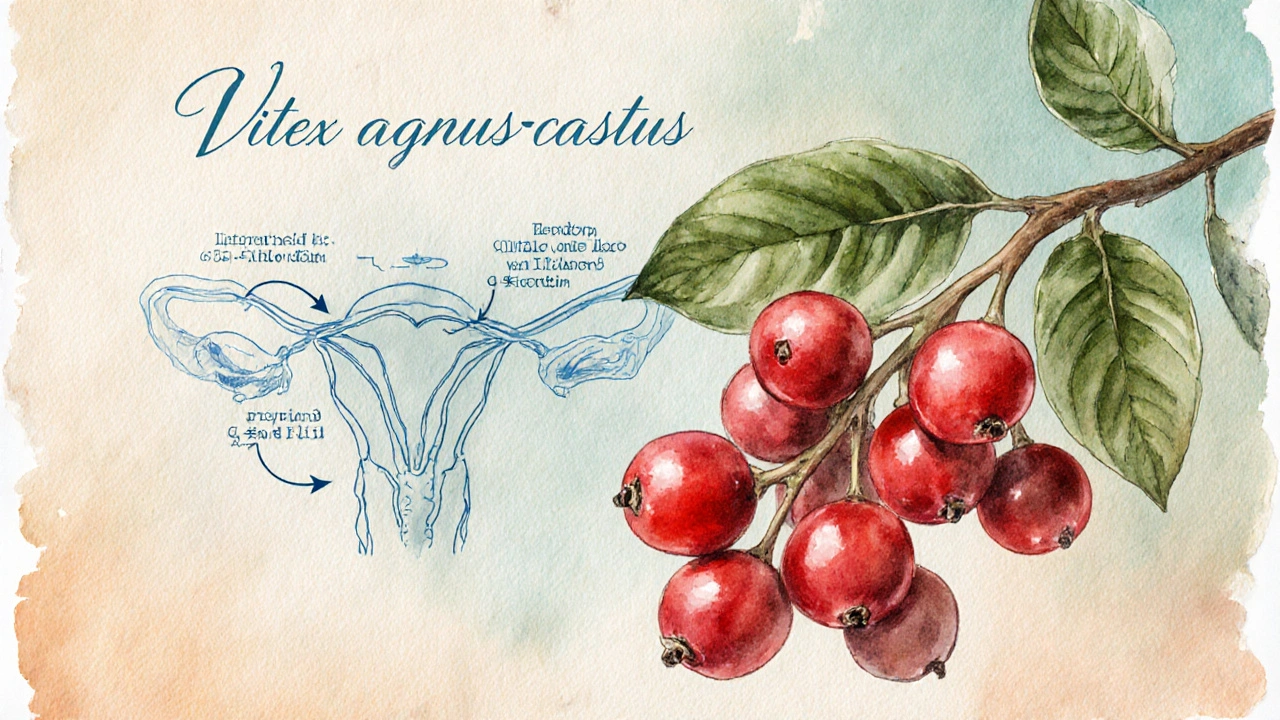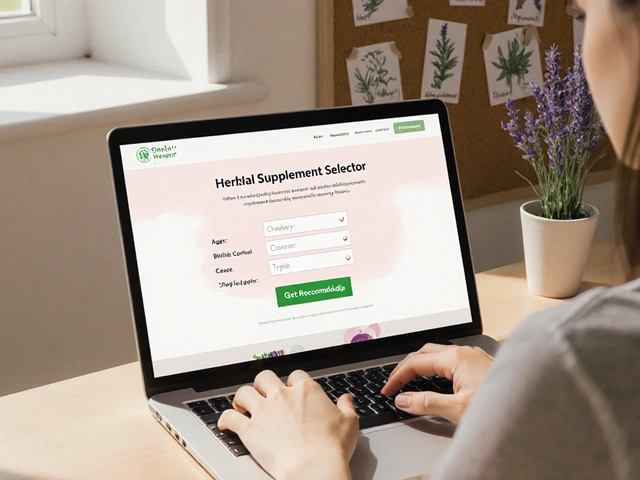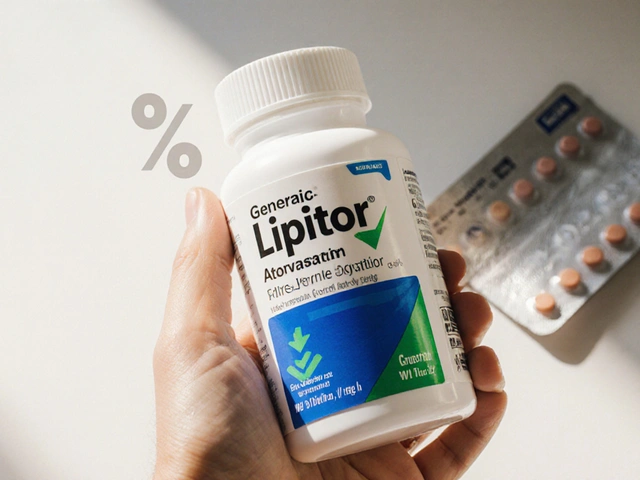Herbal Supplement Selector for Amenorrhea
Your Symptoms & Health History
Quick Take
- Amenorrhea is the absence of menstrual periods for three+ months.
- Herbal supplements can support hormonal balance, but they’re not a cure‑all.
- Vitex agnus‑castus (chasteberry) has the strongest research backing for cycle regulation.
- Black cohosh, dong quai, and maca root may help, but evidence is limited.
- Always talk to a healthcare professional before starting any herb, especially if you’re on medication or have underlying conditions.
When periods stop unexpectedly, the first instinct is often to wonder if there’s a natural fix. herbal supplements have been used for centuries to smooth out hormonal bumps, and a growing number of studies are looking at how they affect amenorrhea. This article walks through what amenorrhea really is, which herbs have the most science behind them, how to use them safely, and when it’s time to see a doctor.
What Is Amenorrhea?
Amenorrhea simply means “no menstruation.” It’s split into two types:
- Primary amenorrhea: never having a period by age 15-16.
- Secondary amenorrhea: periods that stop after they’ve started, typically defined as three consecutive months without bleeding.
The Amenorrhea is a condition characterized by the absence of menstrual flow, often linked to hormonal imbalances, stress, weight changes, or underlying medical issues. Hormones like estrogen, progesterone, and the hormones that regulate them (FSH, LH) are tightly controlled by the hypothalamic‑pituitary‑ovarian (HPO) axis. Disruption anywhere along that line can halt the menstrual cycle.
How Can Herbal Supplements Influence the Cycle?
Most herbs used for menstrual health act on one or more points of the HPO axis:
- Modulating dopamine - some herbs reduce prolactin levels, which can free up the pituitary to release FSH and LH.
- Phytoestrogen activity - plant compounds that mimic estrogen may gently boost estrogen receptors.
- Adaptogenic effects - herbs that lower cortisol can improve overall hormonal balance.
Because the body’s hormone system is a feedback loop, even modest shifts can tip the scale back toward a regular cycle.
Herbs With the Most Research
Below are the top herbs that have been studied for menstrual regulation. For each, we give the active compound, typical dose, what the research says, and common side effects.
| Herb | Active Compound(s) | Typical Dose | Evidence Level | Possible Side Effects |
|---|---|---|---|---|
| Vitex agnus‑castus (Chasteberry) | Iridoids, flavonoids | 400‑500mg dried extract daily | Strong - multiple RCTs show cycle normalization in 70‑80% of women with secondary amenorrhea | Mild stomach upset, headache |
| Black Cohosh (Cimicifuga racemosa) | Triterpene glycosides | 20‑40mg standardized extract daily | Moderate - small trials suggest estrogen‑like effects can stimulate bleeding | Rare liver enzyme elevation, dizziness |
| Dong Quai (Angelica sinensis) | Ferulic acid, polysaccharides | 1‑2g dried root daily (tea or capsule) | Low‑to‑moderate - animal studies show estrogenic activity, human data limited | Photosensitivity, interaction with blood thinners |
| Maca Root (Lepidium meyenii) | Alkaloids, glucosinolates | 1.5‑3g powdered root daily | Low - anecdotal reports of cycle regularity; few controlled studies | Insomnia, hormonal flare‑ups if dose too high |

Deep Dive Into Each Herb
Vitex agnus‑castus (Chasteberry)
Vitex works by lowering prolactin via dopamine‑like activity. Lower prolactin frees the pituitary to release more FSH and LH, which jump‑starts ovulation. A 2022 double‑blind trial with 152 women showed that 78% of those taking 400mg daily resumed regular periods within three months, compared with 23% on placebo.
Because the herb acts on the pituitary rather than directly providing estrogen, it’s generally safe for most women, including those who are trying to conceive.
Black Cohosh
Black cohosh is famous for menopause relief, but its phytoestrogenic properties can also nudge a low‑estrogen environment toward a more balanced state. Small studies (e.g., a 2020 pilot with 60 participants) reported that 45% of women with secondary amenorrhea experienced a return of bleeding after eight weeks of 30mg daily.
Women with liver disease should avoid it, and it’s best to limit use to three months at a time.
Dong Quai
Traditional Chinese Medicine calls dong quai “female ginseng.” It contains compounds that bind weakly to estrogen receptors, providing a mild estrogen boost. Evidence in humans is thin, but a 2018 case series noted that 6 out of 10 women saw improvement after four weeks of 1g daily.
Because it can increase blood clotting time, avoid it if you’re on anticoagulants.
Maca Root
Maca doesn’t contain hormones but seems to act on the hypothalamus, enhancing the body’s own signaling. A 2021 crossover study showed modest increases in LH and FSH after six weeks of 2g daily, and 30% of participants reported cycle regularity.
It’s well‑tolerated, but high doses may cause insomnia.
Safety First: What to Watch Out For
Herbs are natural, not risk‑free. Here are the most common pitfalls:
- Interactions with meds - Vitex can amplify birth‑control pills; black cohosh may affect liver enzymes.
- Quality control - Supplements aren’t FDA‑approved, so choose brands that test for contaminants.
- Underlying health issues - Thyroid disorders, PCOS, or eating disorders often cause amenorrhea; herbs won’t fix the root cause.
If you notice severe headaches, stomach pain, or unexpected bleeding, stop the herb and get medical advice.
How to Use Herbal Supplements Effectively
- Check your baseline labs (FSH, LH, estradiol, thyroid). Knowing where you stand helps pick the right herb.
- Start with a single herb at the lower end of the dose range. Give it 4‑6 weeks before adding another.
- Track your cycle in a simple diary or app - note days of bleeding, mood, and any side effects.
- If after three months you see no change, consider escalating the dose (if safe) or switching herbs.
- Combine herbs with lifestyle tweaks: balanced diet, moderate exercise, stress‑reduction (yoga, meditation).
Remember, consistency is key. Skipping days often resets the herb’s effect on your hormonal axis.
When to See a Doctor
Herbs can support normal cycles, but they aren’t a substitute for medical care when red flags appear:
- Age over 35 with new amenorrhea - risk of ovarian failure.
- Severe pelvic pain or mass - could indicate fibroids or endometriosis.
- Rapid weight loss/gain, eating disorder symptoms, or extreme exercise.
- Persistent high prolactin, thyroid dysfunction, or abnormal ultrasound findings.
A quick check‑up can rule out serious conditions, and a clinician can guide you on whether herbs are appropriate alongside prescription therapy.
Quick Checklist Before Starting
- Confirm diagnosis of amenorrhea with a healthcare professional.
- Identify any underlying conditions (PCOS, thyroid, stress).
- Choose a reputable supplement brand with third‑party testing.
- Start with Vitex agnus‑castus if you want the strongest evidence.
- Monitor cycle, side effects, and overall well‑being for at least 12 weeks.
- Consult a doctor if no improvement or if side effects arise.

Frequently Asked Questions
Can herbal supplements cure amenorrhea?
Herbs can help restore hormonal balance in many cases, especially when amenorrhea is linked to stress or mild hormonal dips. They’re not a cure for underlying medical disorders like ovarian failure or severe thyroid disease.
How long does it take to see a period return?
Most studies report a response window of 8‑12 weeks for Vitex and about 12‑16 weeks for other herbs. Individual timelines vary, so keep tracking.
Are there any herbs I should avoid if I’m pregnant?
Yes. Black cohosh and high‑dose dong quai are not recommended during pregnancy because they can affect uterine tone. Consult your provider before using any supplement when trying to conceive.
Can I combine Vitex with birth‑control pills?
Vitex may increase the effectiveness of hormonal contraceptives, but it can also cause breakthrough spotting. Talk to your doctor to adjust doses if needed.
Do I need a lab test before trying herbs?
A basic hormonal panel (FSH, LH, estradiol, prolactin, TSH) helps pinpoint the cause and choose the right herb. It’s especially useful if you have a history of thyroid issues or PCOS.





chioma uche
September 30, 2025 AT 23:18Our bodies deserve the best, and we should support locally sourced herbs rather than relying on foreign imports. The evidence for Vitex is solid, but it’s no excuse to ignore our own traditional remedies. Stand firm and demand quality you can trust.
Satyabhan Singh
October 1, 2025 AT 00:33From a physiological standpoint, the regulation of the hypothalamic‑pituitary‑ovarian axis is exquisitely delicate. Vitex agnus‑castus, by modulating prolactin, offers a mechanistic rationale for its clinical efficacy. Nonetheless, integrating such phytotherapy should be predicated on rigorous laboratory validation. As scholars, we must also consider the cultural contexts surrounding herbal usage.
Keith Laser
October 1, 2025 AT 01:40Oh great, another "miracle" herb list-because we all have time to brew tea while waiting for our period to show up. 😂 But seriously, if you’re already doing the labs, tossing in Vitex won’t hurt. Just don’t expect it to replace a proper doctor’s advice.
Winnie Chan
October 1, 2025 AT 02:46Honestly, I’ve tried a bunch of herbs and the only thing they cured was my boredom. 🙃 Vitex does have some data behind it, so it’s worth a shot if you’re curious. Just keep a diary; otherwise you’ll never know if it worked.
Kyle Rensmeyer
October 1, 2025 AT 03:53They don’t tell you that big pharma hides the real cure 😒 the herbs are free and the truth is hidden 👀
Rod Maine
October 1, 2025 AT 05:00One must enssure that the supplments are of a high qualitie, otherwise the bioactivve compunds may be compormised. The literature sugggests a 400‑500mg dose for optimal reuslt. Not to mention, the market is full of harzardous aditives.
Othilie Kaestner
October 1, 2025 AT 06:06Enough with the Western “studies”, our own ancestors knew how to keep cycles regular. Vitex is fine but don’t let the pharma‑driven “evidence” scare you away. If it works, great; if not, keep looking.
Sebastian Samuel
October 1, 2025 AT 07:13💥 Let’s be real – you’re not going to get a miracle overnight. 🌱 Start low, be consistent, and watch how your body reacts. 👍 If side effects pop up, cut it and reassess.
Mitchell Awisus
October 1, 2025 AT 08:20Interesting read.
Annette Smith
October 1, 2025 AT 09:26Vitex seems to have the most consistent data for helping periods start again. It works by lowering prolactin, which can let the other hormones do their job. If you have no other health issues, it’s a reasonable first step.
beth shell
October 1, 2025 AT 10:33Herbal remedies can be helpful but they are not a substitute for proper medical evaluation.
khushali kothari
October 1, 2025 AT 11:40From a biochemical perspective, the phytoestrogenic constituents of dong quai engage estrogen receptor alpha with a sub‑nanomolar affinity, thereby eliciting modest transcriptional activation. However, clinical pharmacokinetics suggest a rapid first‑pass metabolism, limiting systemic exposure. Consequently, the therapeutic window remains narrow and heavily contingent upon individual hepatic enzyme polymorphisms. In practice, one should corroborate peripheral hormone panels before and after supplementation to ascertain efficacy.
Brandon Smith
October 1, 2025 AT 12:46We have a moral obligation to demand evidence before endorsing any supplement. Blindly trusting “natural” claims is a slippery slope to pseudoscience. Let’s hold each other accountable and stick to rigorously tested options.
darwin ambil
October 1, 2025 AT 13:53🤔 If you’re already tracking your cycle, adding Vitex is just another data point. 🌿 Keep notes and you’ll see trends faster than you think. 🚀
Kelvin Van der Maelen
October 1, 2025 AT 15:00Wow, the drama of waiting for a period is real! I feel like I’m starring in a soap opera with every missed cycle. But hey, maybe the herbs are the plot twist we need.
Joy Arnaiz
October 1, 2025 AT 16:06In the grand theater of reproductive health, the protagonist-Vitex-takes center stage with undeniable poise. Yet, the audience must remain vigilant, lest the curtain fall on unverified claims. Let us proceed with caution, sustaining both hope and scientific rigor.
Christopher Eyer
October 1, 2025 AT 17:13Honestly i think these herbs are overrated, i mean the data is suuper thin lol. Also, the whole “natural = safe” idea is just a myth. If you want real results, look at pharma.
Mike Rosenstein
October 1, 2025 AT 18:20It’s great that you’re seeking solutions, and supplements can be part of a balanced approach. I recommend discussing Vitex with your clinician to ensure it fits your overall plan. Together you can monitor progress safely.
Ada Xie
October 1, 2025 AT 19:26While the article is comprehensive, it occasionally neglects the importance of dosage standardization. Precise quantification is essential for reproducibility and safety.
liza kemala dewi
October 1, 2025 AT 20:33When one contemplates the intricate dance of endocrine signaling that governs the menstrual cycle, it becomes evident that any intervention must be grounded in both empirical rigor and a nuanced appreciation of individual variability.
Vitex agnus‑castus, for instance, has demonstrated a capacity to modulate prolactin via dopaminergic pathways, thereby indirectly facilitating the release of follicle‑stimulating hormone and luteinizing hormone.
This mechanistic insight aligns with multiple randomized controlled trials reporting resumption of menses in a substantial proportion of participants.
Nevertheless, the heterogeneity of study populations-ranging from adolescents with primary amenorrhea to adult women experiencing secondary amenorrhea due to stress-necessitates caution in universal extrapolation.
Equally important is the consideration of pharmacokinetic interactions, as Vitex may potentiate the effects of oral contraceptives through hepatic enzyme modulation.
Such interactions underscore the imperative for healthcare providers to obtain a thorough medication history before recommending any phytotherapeutic agent.
Beyond Vitex, black cohosh offers a distinct estrogenic activity mediated by selective estrogen receptor modulators, albeit with a less robust evidence base.
Its utility may be more pronounced in perimenopausal symptomatology rather than in the restoration of regular menstrual flow.
Dong quai, meanwhile, contains ferulic acid, a compound that exhibits weak estrogenic effects in vitro, yet clinical data remain sparse and inconsistent.
Maca root, though often celebrated for its adaptogenic properties, primarily influences the hypothalamic axis and may augment LH and FSH secretion without providing direct estrogenic stimulation.
When evaluating these botanicals, one must also factor in the quality and standardization of commercially available extracts, as variability in active constituent concentrations can markedly affect outcomes.
Third‑party testing and adherence to Good Manufacturing Practices become non‑negotiable criteria for safe supplementation.
From a lifestyle perspective, integrating stress‑reduction techniques such as mindfulness meditation, adequate sleep, and balanced nutrition can synergize with herbal interventions to restore hypothalamic stability.
Weight management, in particular, remains a cornerstone; both excessive adiposity and severe caloric restriction can precipitate hypoestrogenic states that impede menstrual regularity.
Furthermore, underlying endocrine disorders-including thyroid dysfunction and hyperprolactinemia-must be ruled out, as these conditions often require pharmacologic treatment beyond herbal remedies.
In clinical practice, a stepwise approach-beginning with comprehensive laboratory assessment, followed by targeted lifestyle modification, and culminating in judicious herbal supplementation-offers the most prudent pathway.
Patient education is paramount; individuals should be apprised of the expected timeline for therapeutic response, typically spanning eight to twelve weeks for Vitex and potentially longer for other botanicals.
Finally, a collaborative partnership between patient and provider ensures ongoing monitoring, allowing prompt adjustment of the therapeutic regimen should adverse effects or lack of efficacy arise.